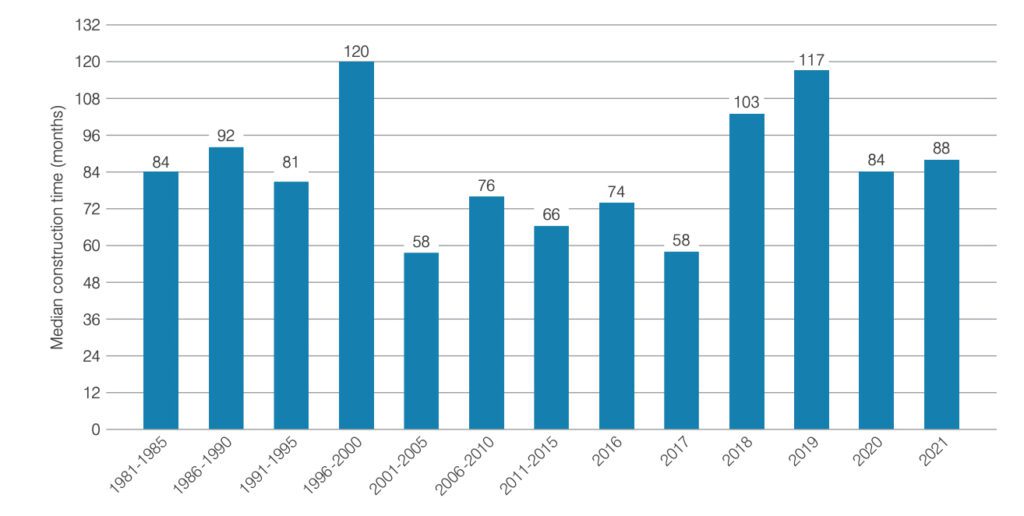Being Pro-Nuclear Won’t Be Enough—Here’s Why
Credit to Author: Sonal Patel| Date: Tue, 03 Jan 2023 05:14:19 +0000
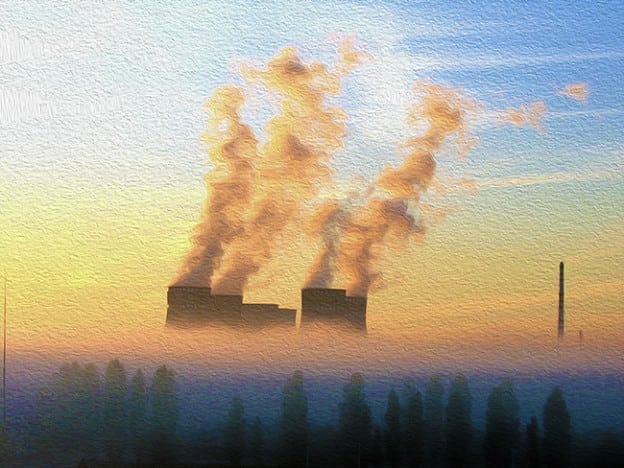
Nuclear energy—not just nuclear power—is seeing a burst of innovation unlike anything seen since the 1950s. While the strong momentum for the dispatchable zero-carbon energy source is promising, prominent pitfalls threaten necessary progress.
While the nuclear industry has sought acceptance by climate advocates for nearly a decade, events over the past year appear to have buoyed nuclear’s prospects and finally set it afloat within the discourse about decarbonization.
The dramatic shift took shape as the energy crisis churned up energy markets across the world and intensified after Russia’s invasion of Ukraine. As well as forcing policymakers to acknowledge the value of power resource diversity for energy security, it has highlighted an especially more forceful edge for dispatchable zero-carbon energy sources as the world sets out to meet ambitious climate policy goals. But the ongoing crisis has also highlighted the urgency at which the world must achieve its rapid transition.
An increasing number of energy leaders have conceded that these attributes cannot be fulfilled without nuclear energy. While Dr. Fatih Birol, executive director of the International Energy Agency (IEA), in May heralded only the possibility that nuclear was poised for an expansion, in November, he declared: “Nuclear power is making a comeback—and in a strong fashion.”
Gearing up for a Steep Ascent
Signals about nuclear’s potentially strong momentum reflect a deep relief for the nuclear industry, which lamented nuclear power’s diminishing share of global generation only two years ago. The International Atomic Energy Agency (IAEA) in a September 2022 report noted nuclear’s share of the world’s total generation at the end of 2021 stood at 9.8%—a steep decline compared to nuclear’s share of 18% in the late 1990s.
And while the world’s operational 422 nuclear power reactors—a total net power capacity of 378 GWe—exceeded the total combined contribution of wind and solar PV worldwide, two out of every three operational reactors was more than 30 years old. The IAEA has warned that retirements are set to accelerate in the coming years, estimating that between 8% to 18% of the existing fleet could be retired by 2030 as reactors approach the end of their licensed timeframes or are forced to close owing to policy-driven phaseouts and economic challenges.
The IAEA, however, remains optimistic that nuclear capacity will expand during the coming decades. For the second successive year, the agency revised up its annual projections, estimating a nuclear power production increase of between 12% to 40% between 2021 and 2030—and between 29% and 250% by 2050. The stark gaps are rooted in assumptions in the agency’s “low” and “high” cases. While each case considers “uncertainties inherent in projecting trends,” the low “conservative” case assumes that current market technology and resource trends will continue, and few changes occur on the nuclear legal, policy, and regulatory landscape. The high case, while “ambitious,” reflects “plausible and technically feasible” projections that are based on “the expressed intentions” by countries that have contemplated expanding their use of nuclear power.
A specific point the agency hammers in its report is that nuclear capacity additions, which last peaked in the 1980s, are beginning to see a revival. By 2050, the low case projects only a slight increase of about 404 GWe above the world’s current 378-GWe capacity, while the high case projects a virtual doubling to 873 GWe. As of November 2022, however, only 57 reactors with a total capacity of 59 GWe were under construction (Figure 1).
That’s far from enough to keep the Paris Agreement 1.5-degree target within reach in a cost-effective and socially equitable manner, said Sama Bilbao y León, director general of the World Nuclear Association. “We urgently need significantly more nuclear energy new build rates,” she said. “We need to ramp up to 50 GW per year over the next 10 years and keep up, acting until 2050.”
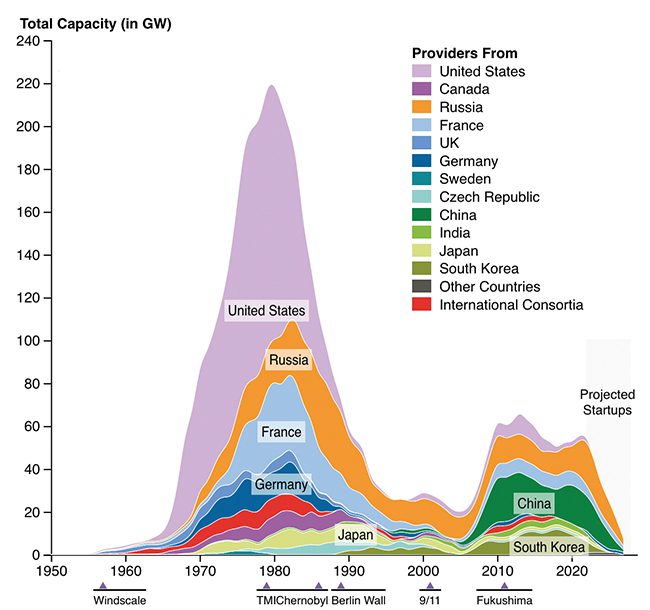 |
1. About 57 reactors were under construction in November 2022, a combined capacity of 59 GW. Most were in China, which is currently building 16.1 GW. South Korea is building 5.6 GW, while Turkey (4.4 GW), India (4.2 GW), Russia (3.8 GW), and the UK (3.3 GW) are other countries near the top of the list. Courtesy: World Nuclear Industry Status Report 2022 (WNISR) with IAEA-PRIS |
Optimism Rooted in Policy Boosts
For now, at least, government support has been pivotal in fueling tangible prospects for new nuclear. In the U.S., where the federal government is spearheading a nuclear revival, “The conversation today is really fundamentally different than it was even just a few years ago,” noted Maria Korsnick, president and CEO of North American industry trade group the Nuclear Energy Institute (NEI). “I know in the U.S., for example, at the state level, we had just a few pieces of legislation that were working through state legislatures that would have been a big deal. Today, we find there’s over a hundred pieces that are working through state houses that have something to do with nuclear, as well as at a federal level in the U.S.,” she said.
In Europe, while some governments like Germany temporarily halted imminent closures for energy security reasons, France—which already derives the majority of its power from nuclear—plans to extend some existing reactor lifetimes and build six new large reactors starting in 2028 at the cost of €50 billion. The UK’s 2022 Energy Security Strategy, meanwhile, calls for eight new large reactors as well as small modular reactors (SMRs) to add 24 GW of new nuclear by 2050. The Netherlands, too, is in discussions to build two new nuclear plants, and several Central European countries, like Poland, the Czech Republic, and Ukraine have cemented state support for new builds, owing to energy security concerns.
In Asia, China’s 14th Five-Year Plan (2021–2025) continues to bolster steady progress for a renewed target to deploy 70 GW of nuclear by 2025—a dramatic increase compared to its already ambitious 53-GW target at the beginning of 2022. And South Korea and Japan’s recent policy reversals to embrace nuclear for future energy security will support lifetime extensions, and restart existing reactors and construction. Finally, India is expected to start building a new 9-GW, 10-reactor fleet between 2023 and 2025.
At the same time, the nuclear industry’s long-cultivated campaign to keep existing reactors online longer—a cost-effective option that the IEA says competes with low-cost solar PV and wind under most conditions—is finally reaping gains. The U.S. has so far issued 20-year extensions to the original 40-year operating licenses for 88 reactors and awarded subsequent license renewals (SLRs) to six reactors, extending their operational lifetimes to up to 80 years. Another 16 U.S. reactors have so far applied for SLRs. Meanwhile, recent extensions for plants in Hungary, Finland, the Czech Republic, and the UK have prevented “the closure of nearly one-quarter of total capacity that would otherwise have occurred in 2020,” the IEA noted.
Demand Ramping Up for SMRs, Advanced Nuclear
In tandem, extraordinary progress over the past four years for advanced reactors is ushering in the real possibility that part of the future new build could comprise smaller, more modular, and versatile reactors. Industry has so far launched an array of “advanced reactor” concepts including water-cooled reactors; high- and very-high-temperature reactors; and sodium, lead, and gas-cooled reactors with fast neutron spectrum, molten salt reactors, and most recently, microreactors (see sidebar, “A Murky Category: Advanced Nuclear Reactors“). A variety of advanced reactor projects are meanwhile making quick progress worldwide, most notably in the U.S. and Canada. Much-watched reactor designs developed by X-energy, TerraPower, GE-Hitachi, NuScale Power, Ultra Safe Nuclear Corp., Oklo, and Kairos Power may approach full-scale demonstration by the late 2020s and early 2030s.
A Murky Category: Advanced Nuclear ReactorsAs defined by the 2019 U.S. Nuclear Energy Innovation and Modernization Act (NEIMA), “advanced reactors” denote reactors with significant improvements compared to existing commercial reactors. For example, “additional inherent safety features; significantly lower levelized cost of electricity; lower waste yields; greater fuel utilization; enhanced reliability; increased proliferation resistance; increased thermal efficiency; or ability to integrate into electric and nonelectric applications,” explained the Nuclear Innovation Alliance (NIA), a “think-and-do” tank that works to enable advanced nuclear power worldwide.
While advanced reactors may include small modular reactors (SMRs)—a term that describes reactors of less than 300 MW size and their ability to combine multiple standardized modules, not their technology—most SMRs making progress so far are light water reactors (LWRs). “Advanced nuclear” also encapsulates microreactors—reactors of 10 MW or less. “In general, it is more useful to categorize advanced reactors according to their neutron spectrum, what kind of atoms they split, the physical form of the fuel they use, the choice of moderator, and the coolant,” NIA says. 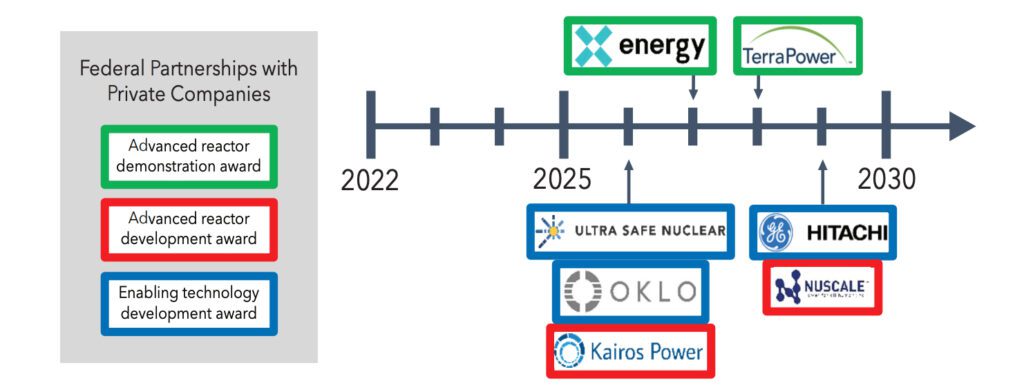 |
These first-of-a-kind (FOAK) projects will deliver crucial technology, business, and regulatory learning. That will “facilitate lower costs and shorter construction timelines for subsequent nth-of-a-kind (NOAK) reactors due to wide-scale deployment and technological learning,” predicted Patrick White, a project manager at the Nuclear Innovation Alliance. “Utilities and other customers that gain early experience with FOAK or early NOAK projects will be in competitive positions to become technology leaders,” he said.
Finally, as interest and investment burgeon in these new concepts, actual demand for advanced nuclear technologies is also flourishing. In an October-released analysis of the advanced nuclear market, Washington D.C.–based public policy think tank Third Way and research network Energy for Growth Hub suggested governmental efforts to promote advanced nuclear with an energy security edge has led “to real expressions of interest” in and demand for advanced nuclear (Figure 2).
“Unlike prior years, we are no longer just talking about the global market in the abstract—we now have concrete examples of real demand for these technologies,” the groups said. The groups’ analysis, for the first time since it was rolled out in 2020, also indicates an emerging market for nuclear demand growth beyond electricity, including for desalination, industrial heat, electric vehicles, and coal replacement.
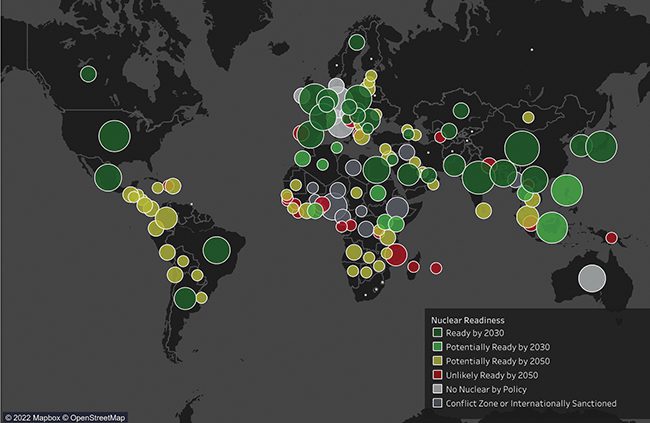 |
2. Analysis by Third Way and Energy for Growth Hub to determine global civil nuclear “readiness” suggests the once-potential market for advanced nuclear is now becoming “real.” About 52 countries could feasibly be markets for advanced nuclear power before 2050. This includes 10 countries that don’t currently have operating commercial nuclear plants, the groups said. Courtesy: Third Way, Energy for Growth Hub |
Nuclear’s Most Forceful Engine: InnovationWhile the commercial nuclear industry has championed innovation since its advent nearly 70 years ago to boost plant economics, efficiency, and flexibility, “[t]oday, we are observing a burst of innovation in the nuclear energy arena that is unlike anything seen since the 1950s,” noted William D. Magwood, IV, director-general of the Nuclear Energy Agency (NEA) in October.
“Generation IV technologies, long explored in the laboratories of government ministries, are moving from experiment and concept to large-scale demonstration,” he said. Small Modular Reactors (SMRs) are meanwhile incorporating lessons learnt from 60 years of commercial nuclear operational experience, and “new innovations, insights and technologies from other sectors, are approaching commercial reality far sooner than some had predicted,” Magwood said. “Even modernized Generation III designs are coming to market in parallel with the new breeds of nuclear technologies.”
Innovation, however, is also thriving in other critical segments, promising to shift nuclear’s long-standing paradigm.
Non-electric Nuclear Energy Applications. “Products beyond electricity generation are coming into view over the longer term—heat for industry, hydrogen for transport, clean water for cities,” Magwood noted. During 2021, a total of 61 operating nuclear reactors were used for non-electric applications. Of these, 48 supported district heating, three reactors supported industrial process heat, five supported both district and process heating, and another five, desalination. According to the International Atomic Energy Agency (IAEA), nuclear heating technology appears poised to flourish even more if the hydrogen economy takes off. A recent scoping investigation by the IAEA suggests nuclear energy could be the most cost-effective means of producing clean hydrogen if gas prices remain above $10–$15 per million British thermal units.
Fuel Cycle. While nuclear fuel production is already mature, automation and digitalization offer continuous safety and efficiency improvements. Progress is also unfolding for fuels developed after the Fukushima disaster, including accident-tolerant fuels, and fuels for current and next generations of nuclear power reactors, which will use high-assay low-enriched uranium (HALEU)—uranium-235 enrichments of up to 20%. These fuels promise to improve the economics and sustainability of nuclear power by increasing fuel irradiation cycles and higher burns. In parallel, efforts are picking up to develop new fuel cycles and recycle spent nuclear fuel. Significant progress in technologies supporting nuclear waste disposal, a long-standing industry concern, is also starting to show gains. Finland is approaching operating its deep geological repository (DGR) in 2025, and Sweden, which garnered government approval, envisions its DGR will be fully developed in the 2080s.
Digitalization. Digital capabilities, including artificial intelligence and machine learning, and data analysis tools are transforming the way nuclear systems are being designed, licensed, and operated.
Fusion. More fusion enterprises have begun cropping up, backed with private capital. While fusion still needs substantial development, ambitious demonstrations are taking shape outside ITER. In October, the UK Atomic Energy Authority picked a coal power plant site for its STEP demonstration, whose first operation is targeted for the early 2040s. In a pivotal breakthrough announced in December, researchers at the National Ignition Facility (NIF) at the U.S.-based Lawrence Livermore National Laboratory achieved fusion ignition—or “scientific energy breakeven,” meaning it produced more energy from fusion than the laser energy used to drive it.
|
Nuclear’s Envisioned Upward Trajectory Rife with Pitfalls
But though the above paints a promising picture for nuclear’s future, the nuclear industry acknowledges a number of conditions will be necessary to achieve the optimistic range of nuclear capacity additions.
The most prominently cited challenge, perhaps, concerns costs. Conventional nuclear plants are massive, complex projects and highly capital intensive, and it’s clear that expanding the global fleet will require a substantial amount of new investment. A high-resolution model compiled by think tank the Breakthrough Institute suggests that incorporating advanced nuclear as part of a “least-cost plan” to achieve a carbon-free grid by 2050 could necessitate cumulative capital investments on the order of $150 billion to $220 billion by 2030 (and up to $1.1 trillion by 2050).
Attracting that investment will require making efforts to manage and address risks. Risks span project risks—including those related to plant construction—technology complexity, political risks, regulatory risks, operational risks, and market or price risks. And as major stakeholders in the industry told POWER, those risks are wide-ranging, and because they are interdependent, they could create a compounding effect that could drive up costs.
Costly Construction Pains
A much-cited factor that directly affects the cost of capital, and, ultimately, a nuclear project’s levelized cost of electricity (LCOE)—is the risk of delays. Most of the world’s largest nuclear fleets—like those in the U.S.—were built between 1955 and 1979. Because those units were smaller and faced less stringent safety regulations, they were built faster than many modern-day units. However, the World Nuclear Industry Status Report 2022 (WNISR)—published by Mycle Schneider, described as an anti-nuclear activist— pointed out (Figure 3), construction times of reactors completed in the 1970s and 1980s were “quite homogenous, while in the past two decades, they have varied widely.” Today, according to the World Nuclear Association, the average construction times for nuclear reactors in operation hover at seven years. “This continues recent trends, where series build and the retention of skills through ongoing new build programmes have helped contribute to more rapid construction times,” the international organization said.
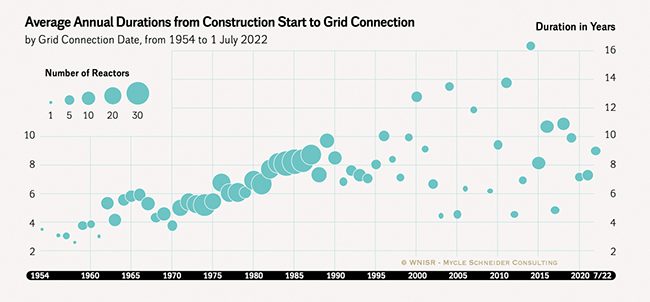
|
3. Average annual durations of the world’s nuclear reactors from construction start to grid connection. As a bright spot, experts suggest that the mean time from construction start to grid connection has been declining recently, falling to 7.1 years in 2021, compared to nearly 10 years in 2019. Top graphic courtesy: WNISR, IAEA-PRIS, 2022; bottom graphic: World Nuclear Association, IAEA-PRIS |
Exorbitant delays and cost overruns at recent large-scale projects in the U.S. and Europe are frequently cited as deterrents for new nuclear within the cautious power industry. Costs on an overnight basis (meaning the cost of a construction project if no interest was incurred during construction, as if the project was completed “overnight” for the first AP1000 reactors built in the U.S. at the 2.23-GW Vogtle expansion in Georgia soared to nearly $9,000/kW owing to a nine-year delay, while similar delays at EPRs under construction at Olkiluoto in Finland and Flammanville in France have nearly quadrupled costs, the IEA estimates. Meanwhile, the two EPRs, a combined 3.3 GW, built at Taishan in China, doubled their construction time to nine years, though their final construction cost amounted to about $3,200/kW.
Industry stakeholders POWER spoke to for this article all agreed that if nuclear power is to remain competitive against other dispatchable low-carbon sources, it must achieve greater declines in construction costs. So far, innovative approaches to achieve more efficient construction already exist or are under development. According to the IEA, the size and complexity of constructing a nuclear plant’s civil works “are typically responsible for much of the delays.” Modularization and standardization could vastly reduce the cost and complexity at plant sites, it has suggested.
Meanwhile, experts at the Breakthrough Institute point out that in traditional nuclear construction projects, the “stacking” or “pancaking” of contract contingencies and profit margins “across a fragmented supply chain has escalated project costs over time.” The think tank in a recent analysis suggests soaring increases in average capital costs per kWh for conventional light-water reactors (LWRs) in the last decade “is mostly due to vendor/supplier agreements and risk management (increasing the cost by 70%), rising commodity prices (adding another 25%), and growing owners’ costs (about 17.5%). Together, these factors more than doubled the costs of traditional nuclear reactors between 2004 and 2011,” it said.
A Complex Set of Risks
While FOAK projects, such as several advanced nuclear projects under construction, are particularly vulnerable to delays, “early capital investment and learning-by-doing” will ultimately lead to substantial project cost reductions and LCOE for advanced nuclear technologies, suggested Dr. Adam Stein, director of the Nuclear Energy Innovation program at the Breakthrough Institute.
For Stein, a more prominent cost challenge relates to project financing, “The single primary driver is the financing rate,” he said. “The interest on a large project that is almost entirely capital upfront—like nuclear—could be almost half of total cost. And so just a one or two percentage change in interest rate is a huge swing for total project cost, even if the actual capital cost for the components hasn’t changed at all.”
“People are used to looking at big projects and saying that this one project had an issue and so every other project will have an issue. And that’s not necessarily the case,” Stein stressed. “But it’s also definitely true that not everything will go perfectly,” he said.
Every project has had its pitfalls, he noted. Delays and cost overruns experienced with the EPRs under construction in Europe stemmed from a low level of design maturity when construction began, challenges with project management, regulatory changes during the construction period, and delays in parts manufacturing in the absence of an active supply chain. All those risks may apply to FOAK advanced reactor projects owing to technology complexity.
However, certain advanced reactors present advantages over larger plants because they can achieve passive cooling and don’t require the mechanically operated reactor coolant systems that large plants typically do, Stein noted. Larger sizes also significantly affect the supply chain by “creating oligopolies”—limited competition—because only certain suppliers can provide large nuclear components. However, the component manufacturing pipeline may still present “a challenging bottleneck” for advanced reactors over the next decade, the Breakthrough Institute notes in a recent report.
One factor is that different nuclear reactor technologies may need varied supply chains, and this may complicate efforts to standardize components. Manufacturing capacity is also a concern. “You could get orders for 100 reactors this year, but you wouldn’t be able to build them all because you literally couldn’t make them all,” Stein said.
Different advanced reactors may also require varied fuel types. The U.S. is notably spearheading actions to increase cost-effective and competitive domestic mining, conversion, and enrichment capacity, with an emphasis on deploying high-assay low-enriched uranium (HALEU) enrichment and deconversion capacity.
Stein suggested supply chain concerns can be addressed strategically, including as they relate to specialized components and specialized fuel. “The strategic elements include preventing future oligopolies, supporting domestic job creation, managing obsolescence, and ensuring nuclear security. Capacity issues include providing the infrastructure to manufacture major components domestically or in close partner countries at a sufficient scale, including providing large forgings, specialized alloys, and fuels,” he said.
Embedding New Nuclear in a Changing Energy System
Ensuring adequate supply chains for a burgeoning new fleet will, however, ultimately hinge on adequate market demand for new nuclear. Positive market signals, for example, could include advanced pre-orders by utility and private customers and public sector procurement of reactor projects, experts said.
Utilities, so far, appear ready. A recent NEI survey suggests the industry trade group’s 19 U.S. utility members expect to add up to 90 GW of new nuclear generation, including more than 300 new SMRs by the 2050s. Utilities like PacifiCorp are evaluating sites that currently host operating or retired coal plants for new SMRs, while several other major utilities like Duke Energy, Southern Co., NextEra, and the Tennessee Valley Authority have recently highlighted nuclear as a centerpiece in their decarbonization strategies.
However, NEI notes utility uptake of new nuclear will be predicated on policy, market, and technology enhancements. The trade group has urged more market certainty through better energy planning “based upon total system costs to customers,” not “methods that do not capture the entire set of benefits of costs,” like LCOE. And along with supporting upgrades to transmission infrastructure, policymakers could bring clarity to capital markets and to operators seeking financing opportunities by fully valuing the benefits of nuclear, it suggested.
Nuclear, especially if boosted with new advanced nuclear capabilities, offers more than its inherent carbon-free attributes. Nuclear’s potential to provide stability, short-term flexibility, and adequate capacity during peak demand periods must also be valued, it said.
The Regulatory Burden
How much new investment nuclear will garner, meanwhile, will depend heavily on policy and regulatory reforms. All experts POWER consulted suggested that new federal regulatory frameworks will be necessary. Existing rules may need to be streamlined to ensure timely licensing and construction of new reactors, particularly advanced reactors, they said.
In the U.S., the current regulatory regime—a global “gold standard” on which many countries’ regulatory regimes are modeled—was developed for existing conventional large LWRs. The licensing framework “is written in a prescriptive manner, which makes it difficult for advanced reactors with different parameters to efficiently progress through the licensing process,” Stein noted. Reform was kicked off with passage of the Nuclear Energy Innovation Modernization Act in 2018, and it spurred the Nuclear Regulatory Commission (NRC) to develop a “Part 53” framework that embraces a technology-inclusive, performance-based, and risk-informed approach.
But progress has been slow. In September, commission staff unveiled a 1,252-page draft proposal. The staff is expected to send the draft to the commission in February 2023, after which the commission will decide if it should be published in the Federal Register, potentially kicking off a formal rulemaking process.
In a recent blog post, experts from the Breakthrough Institute concluded the proposed rule “largely replicates the failed licensing rules that have hobbled the legacy nuclear industry for decades.” And even if the framework is deployed, there are no guarantees it would speed up licensing, Stein noted. Though the framework is intended to enable innovation and commercialization for advanced reactors, advanced reactor project developers are reluctant to risk licensing uncertainties that could arise during the costly regulatory process. “If nobody wants to be the first, then nobody’s going to use it,” Stein said. “They would rather slog their way through the existing framework that they at least have experience dealing with than the new framework that they see no benefit for, because it introduces new requirements, new oversight programs.”
Across the world, efforts are beginning to harmonize codes and standards, and regulatory approaches are beginning to take shape. “However, the advances introduced by innovative nuclear technologies and reactor designs such as SMRs and advanced reactors may deviate from current licensing regimes and practices. The limited regulatory experience with novel designs poses a significant challenge in demonstrating and approving their safety case,” the IAEA noted.
At the same time, though the IAEA’s high case considers nuclear “newcomers,” any substantial progress will be predicated on these countries’ development and implementation of effective regulatory frameworks. There are no guarantees here either, the IAEA noted. However, it said newcomers can engage with the IAEA with a “milestone” approach or “bilaterally with an experienced nuclear nation for capacity building” to facilitate a successful outcome.
An Increasingly Complex Cultural Shift
Finally, experts stress that how nuclear’s current trajectory will play out will depend—as it always has—on a complex, continuously morphing set of factors that affect its myriad parts. The nuclear industry is still a vast amalgam of utilities and power plant operators, research and development performers, regulators, technology vendors, and fuel providers. Over the past few years, this set of key players has absorbed policymakers, as well as the rapidly expanding realm of climate change advocates.
These influences are then laid over the complexities that determine the market’s demand for power and the general power business. Power company financial outcomes have historically determined where investments are prudent, and power company priorities continue to evolve. And today, the power industry is already grappling with a long list of energy transition–related risks, foremost among them reliability, resilience, and environmental compliance. Among additional uncertainties are how it will ensure the availability of skilled and qualified personnel to build and run the envisioned nuclear expansion.
Public opinion, too, will continue to shape nuclear’s progress. But while campaigns to brand nuclear as a pivotal component of future decarbonization initiatives are proving successful, sustaining public support as the industry urgently grapples with prominent challenges may prove a challenge of its own.
—Sonal Patel is a POWER senior associate editor (@sonalcpatel, @POWERmagazine).
Updates/Corrections: This story was updated on Jan. 3 (at 3:45 p.m. CST) to correct a misquote and clarify the NRC’s anticipated timeframe for rulemaking related to the Part 53 framework.
The post Being Pro-Nuclear Won’t Be Enough—Here’s Why appeared first on POWER Magazine.
